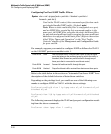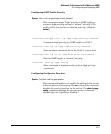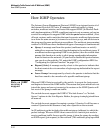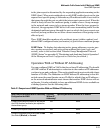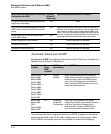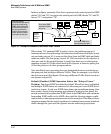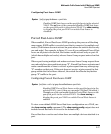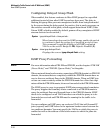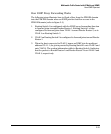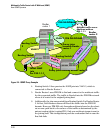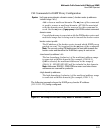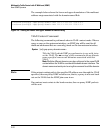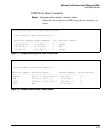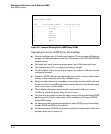
Multimedia Traffic Control with IP Multicast (IGMP)
How IGMP Operates
Configuring Fast-Leave IGMP.
Syntax: [no] ip igmp fastleave < port-list >
Enables IGMP fast-leaves on the specified ports in the selected
VLAN. The no form of the command disables IGMP fast-leave
on the specified ports in the selected VLAN. Use show running
to display the ports per-VLAN on which Fast-Leave is
disabled.
Forced Fast-Leave IGMP
When enabled, Forced Fast-Leave IGMP speeds up the process of blocking
unnecessary IGMP traffic to a switch port that is connected to multiple end
nodes. (This feature does not activate on ports where the switch detects only
one end node). For example, in figure 2-3, even if you configured Forced Fast-
Leave on all ports in the switch, the feature would activate only on port A6
(which has multiple end nodes) when a Leave Group request arrived on that
port.
When a port having multiple end nodes receives a Leave Group request from
one end node for a given multicast group “X”, Forced Fast-Leave activates and
waits a small amount of time to receive a join request from any other group
“X” member on that port. If the port does not receive a join request for that
group within the forced-leave interval, the switch then blocks any further
group “X” traffic to the port.
Configuring Forced Fast-Leave IGMP
Syntax: [no] vlan < vid > ip igmp forcedfastleave <port-list>
Enables IGMP Forced Fast-Leave on the specified ports in the
selected VLAN, even if they are cascaded. (Default: Disabled.)
The no form of the command disables Forced Fast-Leave on the
specified ports in the selected VLAN. Use show running to
display the ports per-VLAN on which Forced Fast-Leave is
enabled.
To view a non-default IGMP forced fast-leave configuration on a VLAN, use
the show running-config command. (The show running-config output does not
include forced fast-leave if it is set to the default of 0.)
Forced fast-leave can be used when there are multiple devices attached to a
port.
2-17




